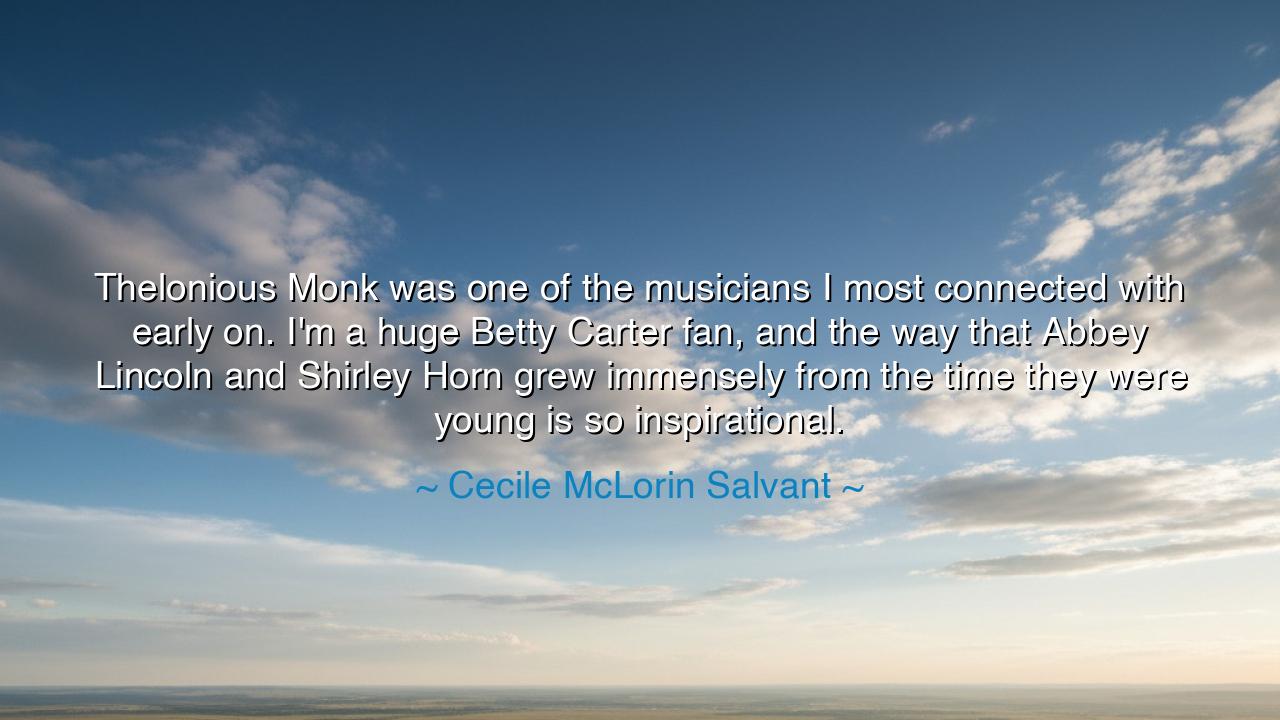
Thelonious Monk was one of the musicians I most connected with
Thelonious Monk was one of the musicians I most connected with early on. I'm a huge Betty Carter fan, and the way that Abbey Lincoln and Shirley Horn grew immensely from the time they were young is so inspirational.






In the words of Cécile McLorin Salvant, the modern keeper of jazz’s living flame, we hear not merely admiration but reverence: “Thelonious Monk was one of the musicians I most connected with early on. I'm a huge Betty Carter fan, and the way that Abbey Lincoln and Shirley Horn grew immensely from the time they were young is so inspirational.” These words, though spoken with the humility of a student, carry the spirit of the ancients — for they speak to the lineage of art, the transmission of wisdom, and the sacred act of growth through listening and becoming. In her reflection, Salvant reminds us that every true artist is both disciple and vessel, drawing from the past to create the future.
When she speaks of Thelonious Monk, she invokes not merely a name, but a force of nature — a mystic of melody, whose music broke the boundaries of form and expectation. To “connect” with Monk is to stand before the temple of originality, where rhythm defies symmetry and beauty emerges from dissonance. In him, Salvant found the courage of imperfection, the holiness of uniqueness. Monk’s piano did not conform to comfort; it challenged the ear, just as the philosopher challenges the mind. To those who listen deeply, his music whispers a timeless lesson: that truth often sounds strange at first, but it is in the strange that the spirit finds freedom.
And when she speaks of Betty Carter, Abbey Lincoln, and Shirley Horn, her words form a trinity of feminine mastery — three women who forged their voices not through imitation, but through evolution. Each began her journey in the shadows of expectation, and each, over time, shaped her art into something unyielding and profound. Betty Carter, the daring improviser, turned every song into an act of rebirth. Abbey Lincoln, the poet and activist, infused her voice with the cry of the human condition. Shirley Horn, with her measured phrasing and intimate silences, taught that restraint can be more powerful than roar. In admiring their growth, Salvant honors not their fame, but their becoming — that sacred process by which the artist transforms life into meaning.
This idea — that art is not born perfect but ripens through time — is as old as civilization itself. The sculptor Michelangelo once said that every block of marble already contained the statue within; the task was only to remove what did not belong. So it is with the soul of the artist. Betty, Abbey, and Shirley did not find their greatness overnight — they carved it slowly, through experience, through pain, through persistence. Each year, each performance, was a stroke of the chisel upon their spirit. What Salvant finds inspirational, therefore, is not only their talent, but their endurance — their willingness to grow visibly, to remain vulnerable before the world while perfecting their craft.
There is a quiet heroism in this kind of evolution. In an age that worships speed and instant success, Salvant’s admiration is a reminder that greatness cannot be rushed. The ancients taught that mastery requires patience, for the tree that grows too quickly bears hollow fruit. So it was with the women she reveres: their music aged like wine, deepening in tone and meaning. In their art, one can hear not only skill, but life itself — the sound of love and loss, joy and sorrow, wisdom and grace. This, perhaps, is the essence of what Salvant calls inspirational: the courage to live long enough within one’s art that it begins to mirror the soul.
And so, her quote becomes not a mere tribute to her heroes, but a reflection of her own path. Cécile McLorin Salvant, like those she honors, carries forward the flame of tradition while forging new light. Her connection to Monk reveals her reverence for originality; her admiration for Carter, Lincoln, and Horn shows her devotion to authenticity and growth. In her, the lineage continues — the river of jazz flowing from one generation to the next, ever-changing yet eternal. For the artist is not a creator in isolation, but a participant in a continuum of inspiration that stretches across time.
The lesson, then, is this: honor those who came before you, but do not merely imitate them — learn from their courage to grow. Whether you are an artist, a teacher, a dreamer, or a builder, remember that mastery is a journey, not a destination. Seek those whose lives have blazed a trail through doubt and transformation. Let their example remind you that your greatest work may come not in youth, but in maturity — when your craft and your soul finally move in harmony.
So, dear listener, take Cécile McLorin Salvant’s words as both a song and a teaching. Be inspired by the Monks who teach you to be fearless in your difference, and by the Bettys, Abbeys, and Shirleys who teach you to grow beyond what you once were. For in every art — and indeed, in every life — the greatest masterpiece is not the one we create, but the one we become.






AAdministratorAdministrator
Welcome, honored guests. Please leave a comment, we will respond soon